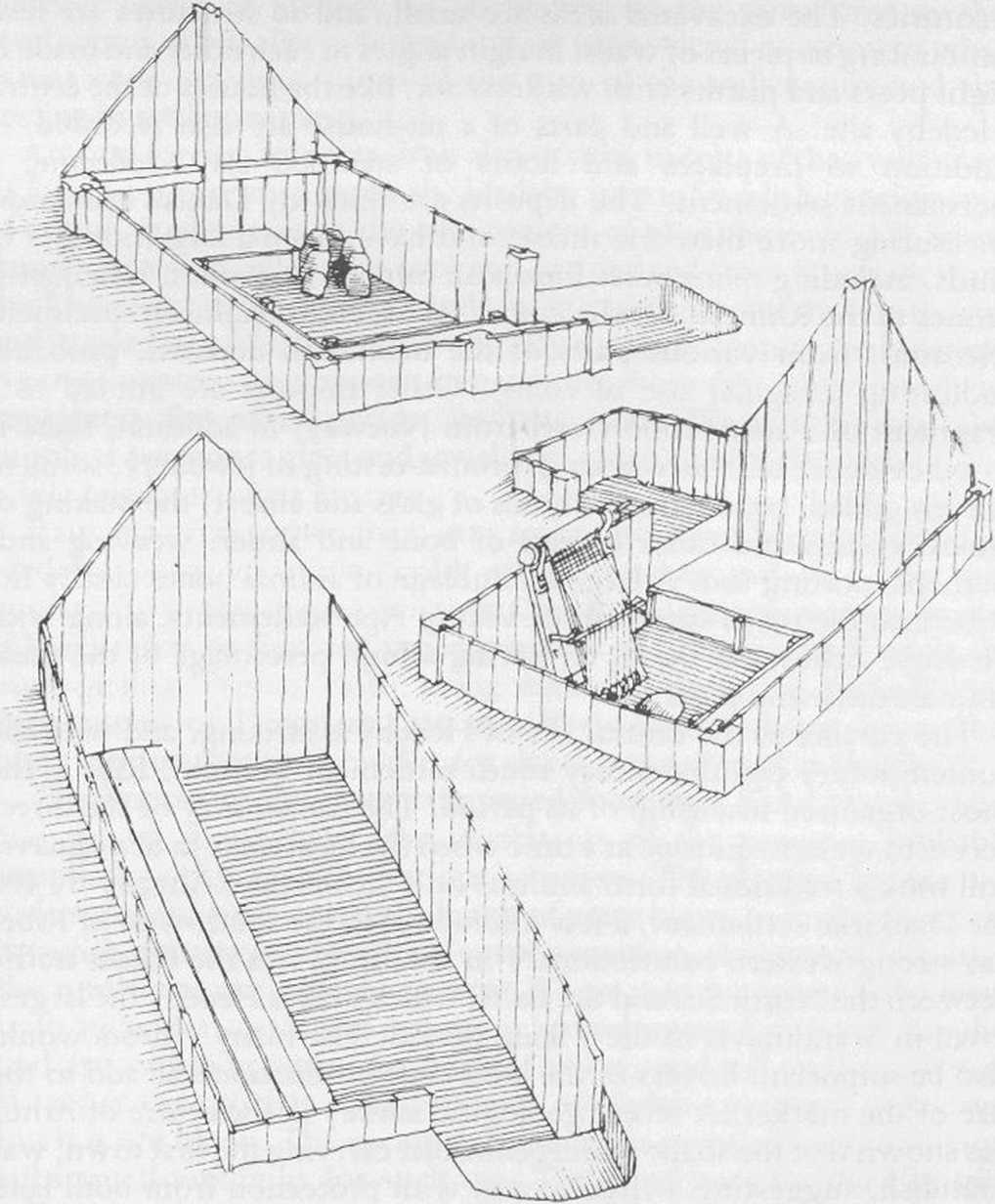49 (253)
92 The Viking Age in Denmark

Figurę 25 Reconstructed tcnth-century pit-houses of the town of Arhus (Jylland). (Aftcr Madsen)
in the quarter above the chamber tombs in the central town. One of the lightly built houses at Arhus contained, among other things, quern-stones, while one of the solid ones, along with habitation, had been used for weaving. Apparently we are dealing with sets of dwellings and warehouses. The light pit-house ncxt to the weaving one, for instance, contained tools for wrood-working and textile-working and fragments ofriding equipment, bronzejewcllery, keys, a comb with a runie inscription, bowls of wood, ceramics and foodstuffs like cereals. It is elear that the relatively modest buildings housed persons of sonie social standing.
' Towns and Fortresses 93
Othcr crafts, reflectcd in the materiał, include the casting of metal artefacts, cornb-production and, perhaps, the working of gold. The imports comprise whetstones and soap-stone vessels from Norway, pottery of Slavonian type, Rhinish lava quern-stones and a little glass, etc., but, apparently no western ceramics. In addition, there is a scalę and a single weight.
With Arhus in mind, we may conceivc of Odense, being identical with the tenth-century settlement inside the ring wali of Nonne-bakken, as a town of the same character and also with minor buildings.71 The plans, however, like most of the archaeological data on the town, are unpublished; but the rampart had about the same diameter as the smali Fyrkat fortress.
Viborg is already mentioned as being a rural settlement in the Viking Age proper lacking the characteristics, in terms of food supply, buildings and activities, otherwise connected with the towns.72 The long-houscs, for instance, making up the excavated settlements, are otherwise known soldy from the town of Lund, where there is only one specimen. In addition, very little evidence ofcraft production, and few, if any, imports are recorded.
Alborg, as noted, remains archaeologically enigmatic before about 1100. From Roskilde the earliest remains, of a stone church, go back to the first half of the eleventh century.73 Othcr historically named sites, like 0rbxk, ‘Wendila’, Toftum, Slagelse, Ringsted, Helsingborg, Borgeby, Thumatorp, Dalby and Gori have no Viking Age archaeological data, or are unknown except for Dalby, where a stone cathedra] wras built in the eleventh century. In addition, some of the localities are probably not towns.
Only from Lund do we still have a substantial amount of data on an early town.74 It is worth noting that the wickerwork fences of the first settlements seem to remain in the same place over time, indicating a lay-out, as in the case of the central site at Hedeby. A Street system is known, in addition to a number of wells. The lightly built structures, including a hall, in plan resembling the Trelleborg type, have wickerwork walls, and only later are stave walls secn, as in the churches (Figs 26-7).
Imports are surprisingly few, while craft activities comprise the production of bronze and tin jewellery, working in bonę and antler (especially combs), the making of ceramics, shoes, and also wood-working and weaving. In spite of the large areas excavated, the materiał spectrum is not much differentiated, and we are secing a kind of site functionally different from the intemational ports of Hedeby and Ribe. Lund is the only inland town we know of archaeologically; but because of its late datę, a reliable comparison with, say, Hedeby is impossible, and the lack of imports - apart, apparently, from some Slavonian and a little English pottery and a little soap-stone — might be due to a shrinking of the International trade in craft products after the
i
Wyszukiwarka
Podobne podstrony:
75 (129) 144 The Viking Age in Denmark Figurę 38 Average weight ofthesilver-hoardsofthe period 900 t
81 (117) 156 The Viking Age in Denmark Figurę 46 Distribution of Arabie coins in a samplc of castcrn
86 (111) 166 The Viking Age in Denmark 166 The Viking Age in Denmark Figurę 56 Coin-dated silver hoa
87 (108) 168 The Viking Age in Denmark North Sea and thc Baltic, and also of craft activities. In th
50 (241) 94 The Viking Age in Denmark Figurę 26 Part of thc city of Lund (Skinę) at the beginning of
22 (669) 38 The Viking Age in Denmark Figurę 8 B. ‘Aftcr Jelling’ Stones in southernmost Jylland. Si
47 (269) 88 The Yiking Age in Denmark Figurę 24 Reconstruction of ninth-century house from the centr
92 (101) 178 The Viking Age in Denmark 18 Adam III, 77; cf. IV, 8 and 9. Ncarby Da
57 (213) 108 The Viking Age in Denmark Platę IV. Silvcr and copper dccorated spurs, length about 21
58 (195) 110 The Viking Age in Denmark Platę VI. Sample from late tenth-century silver-hoard at Taru
60 (189) 114 The Viking Age in Denmark Platc X. Ship-sctting and runestonc (on smali mound) at Glave
62 (179) 118 The Viking Age in Denmark Plato XIV. Iron tools from a tenth-ccntury hoard atTjclc, nor
63 (170) 120 The Viking Age in Denmark % Platę XVI Pagc with illustration of an English manuscript f
64 (171) 122 The Viking Age in Denmark Figurc 30 Distribution of wealth in three cemeteries as measu
66 (160) 126 The Viking Age in Denmark have becn fouhd (Figs 32-3).7 They stem from thc same provinc
68 (153) 130 The Viking Age in Denmark two tortoise bucklcs to reprcsent wornen of high standing, th
69 (151) 132 The Viking Age in Denmark heavy cavalry burials, fincr wcapon graves of thc simple type
70 (150) 134 The Viking Age in Denmark cemetcry at Lejre on Sjaelland a dccapitatcd and ticd man was
74 (134) 142 The Viking Age in Denmark 5C~ł silver 800 900 kxx) A.D. Figurę 37 Fluctuations in che r
więcej podobnych podstron